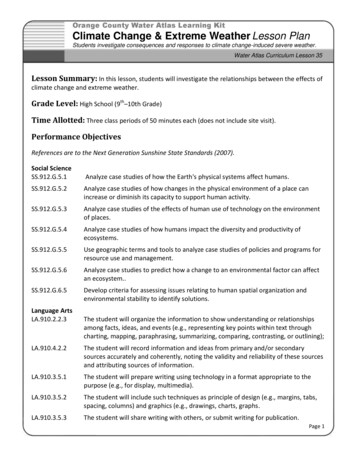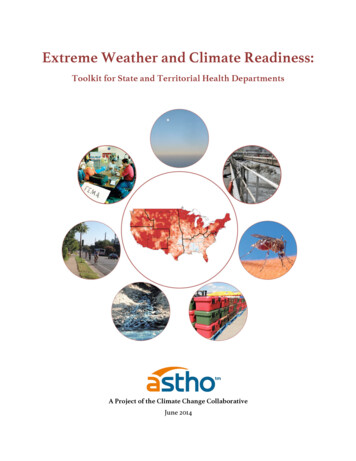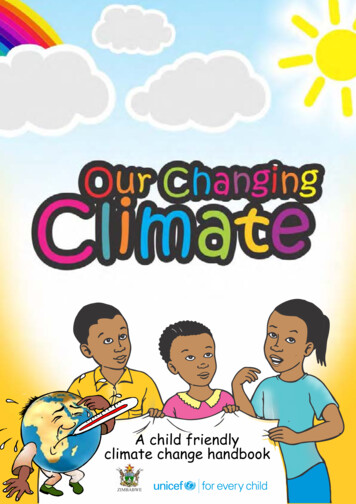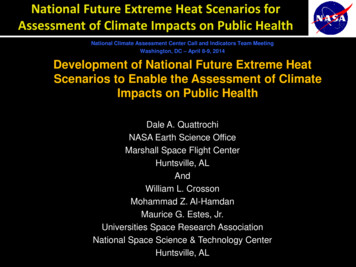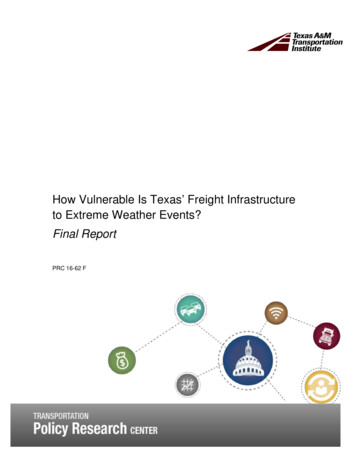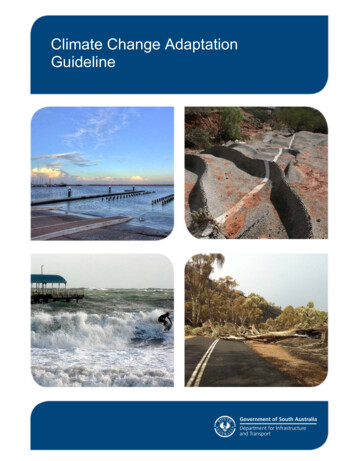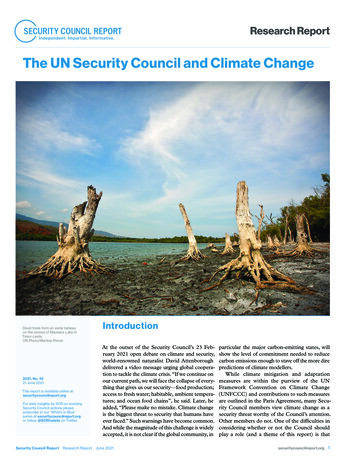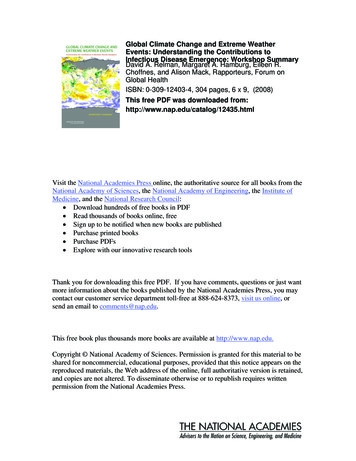
Transcription
Global Climate Change and Extreme WeatherEvents: Understanding the Contributions toInfectious Disease Emergence: Workshop SummaryDavid A. Relman, Margaret A. Hamburg, Eileen R.Choffnes, and Alison Mack, Rapporteurs, Forum onGlobal HealthISBN: 0-309-12403-4, 304 pages, 6 x 9, (2008)This free PDF was downloaded from:http://www.nap.edu/catalog/12435.htmlVisit the National Academies Press online, the authoritative source for all books from theNational Academy of Sciences, the National Academy of Engineering, the Institute ofMedicine, and the National Research Council: Download hundreds of free books in PDF Read thousands of books online, free Sign up to be notified when new books are published Purchase printed books Purchase PDFs Explore with our innovative research toolsThank you for downloading this free PDF. If you have comments, questions or just wantmore information about the books published by the National Academies Press, you maycontact our customer service department toll-free at 888-624-8373, visit us online, orsend an email to comments@nap.edu.This free book plus thousands more books are available at http://www.nap.edu.Copyright National Academy of Sciences. Permission is granted for this material to beshared for noncommercial, educational purposes, provided that this notice appears on thereproduced materials, the Web address of the online, full authoritative version is retained,and copies are not altered. To disseminate otherwise or to republish requires writtenpermission from the National Academies Press.
Global Climate Change and Extreme Weather Events: Understanding the Contributions to Infectious Disease mate, Ecology, and Infectious DiseaseOVERVIEWAs depicted in the convergence model of infectious disease emergence,illustrated in Figure SA-4, climate interacts with, and can alter, the complexecological relationships underlying infectious disease transmission patterns. Thischapter examines such interactions from several perspectives: Their consequences throughout the aquatic-marine food web, whichdefines ecological relationships for water-dwelling animals In patterns of distribution and transmission dynamics of individual infectious diseases (cholera, Rift Valley fever, chikungunya, and plague) Their effects on the dynamics of plant diseases, and their effects on agriculture and natural ecosystems As manifested in the public health challenges posed by climate change tohuman populations in the ArcticResearch on the effects of climate variation on infectious disease incidenceand geographic range in these diverse contexts is providing the basis for developing climate-based early warning systems for disease risk. Such studies alsorepresent a necessary first step toward anticipating how climate change may alterinfectious disease dynamics in various ecological frameworks.In her workshop presentation, Leslie Dierauf, director of the U.S. Geological Survey’s National Wildlife Health Center in Madison, Wisconsin, describedthe apparent and predicted effects of climate on a broad cross-section of animalspecies that inhabit fresh- and saltwater ecosystems, as well as the intertidal104Copyright National Academy of Sciences. All rights reserved.
Global Climate Change and Extreme Weather Events: Understanding the Contributions to Infectious Disease ATE, ECOLOGY, AND INFECTIOUS DISEASE105zones that unite aquatic and marine environments. Ecological connections amongthese environments are illustrated in Figure SA-8, which depicts the marine foodweb.Dierauf also emphasized the physical connectedness of aquatic and marineenvironments, which makes it possible for infectious diseases of fish and wildlife to move from freshwater sources to intertidal zones to marine environments,affecting species that may not have encountered these disease agents before.Salmon, for example, hatch in small freshwater streams, travel hundreds of kilometers downstream to the ocean where they live for several years, only to returnto the same streams where they hatched to spawn and die shortly thereafter. Thus,she observed, “if the temperature of the streams changes or the fish themselvespick up novel disease agents, because a vector, or an intermediate host, or adisease agent thrives in the new warmer environment, infectious disease mayresult.”Evidence-based studies of the effects of climate change on the health ofaquatic and marine wildlife are few, Dierauf reported; therefore, current understanding of this topic derives from such sources as historical comparisons (ofclimatic conditions and of animal health and behaviors), long-term ecologicalresearch, correlation studies, and recognition of the physical, chemical, andbiological processes governing climate change. Following the flow of waterfrom inland streams to estuaries and into the open ocean, Dierauf consideredthe possible impacts of climate change in each of the three main elements of theaquatic continuum and how these changes may affect the health of their animalinhabitants.In freshwater ecosystems, extreme weather events that produce flooding cantrigger overwhelming influxes of nutrients into ecosystems. Storms can cause arange of environmental disturbances; Dierauf described the release of Nile tilapia into Mississippi streams from aquaculture facilities damaged by HurricaneKatrina. Several emerging diseases of inland aquatic animals, described anddepicted in Box SA-2 in the Summary and Assessment, may also be influencedby climate change.Intertidal areas, such as salt marshes and estuaries, are essential for maintaining a delicate balance among many complex and interactive variables (suchas temperature, light, salinity, wave action, sea level rise, erosion, and sedimentdeposition) that characterize the transition from freshwater to saltwater environments, Dierauf explained. Storms, such as hurricanes, greatly affect intertidalzones. Heavy inland rainfall increases the speed and volume of the run-off thatreaches estuaries, while marine storms drive saltwater and its contents past theintertidal buffer, affecting inland ecosystem health.Climate change is expected to produce a range of important effects on oceans(as well as on large, deep-water lakes such as the Great Lakes), according toDierauf. These include increased wave intensity, increased nutrient turnover,changes in nutrients, and changes in the food web. In addition, she noted, higherCopyright National Academy of Sciences. All rights reserved.
Global Climate Change and Extreme Weather Events: Understanding the Contributions to Infectious Disease LOBAL CLIMATE CHANGE AND EXTREME WEATHER EVENTSconcentrations of atmospheric carbon dioxide are dramatically increasing theacidity of ocean waters, which in turn is weakening the carbonate shells andskeletons of many marine species that comprise coral reef systems. She alsonoted the effects of harmful algal blooms (HABs), which are thought to resultfrom nutrient influxes to the ocean (see Summary and Assessment). HABs appearto be increasing in both frequency and size as the climate warms, she said; thiscould result from increased upwelling of nutrients within the ocean or changesin ocean currents, as well as from the effects of extreme weather events inland.“What we do know is that HABs are affecting and often killing living things inthe food web, like zooplankton, shellfish, fish, birds, and marine mammals, likemanatees,” she said.Ocean warming, which is reducing the availability of food and sea ice formarine mammals, may also be compromising their resistance to infectious disease, Dierauf said. “Already, climate change and thinning of sea ice has reducedthe time mother polar bears have to build the fat stores they need to sustainthemselves over winter and to feed their young come spring when they emergefrom their dens,” she noted. Faced with shortages of food in their native waters,some marine mammals move to new territories where they both encounter andintroduce novel disease agents (see Summary and Assessment).“Climate change and climate variability will affect aquatic and marine species worldwide,” Dierauf concluded. “We must act now at personal, professional,local, and global levels to protect vulnerable ecosystems and the aquatic andmarine species that depend on these habitats for survival.”In contrast to the broad perspective on the effect of climate change on aquaticecosystems offered by Dierauf, this chapter’s first paper, by Rita Colwell of theUniversity of Maryland, focuses on the specific and well-characterized effects ofclimate on cholera, a water-borne disease that affects an estimated 100,000 peopleper year, resulting in 10,000 deaths. The incidence and distribution of cholera arecontrolled by water temperature, precipitation patterns, and water salinity—all ofwhich are influenced by global climate—and conducted through a complex webof ecological relationships. Sanitation and infrastructure also play a role in theincidence and distribution of cholera. Colwell noted, however, that “by simplyeducating women to filter drinking water through several layers of ‘sari cloth,’we were able to reduce cholera incidence by 50 percent.” Colwell described how,over the course of decades, she and coworkers deduced the circumstances underwhich the causal agent of cholera, the bacterium Vibrio cholerae, is transmittedto humans by the plankton species with which the bacterium associates. Thisknowledge led to the development of remote sensing systems capable of predicting the onset of cholera epidemics in the Ganges delta, known as the “home ofcholera,” because of its long history of epidemic disease.This chapter’s second paper also describes the use of remote sensing tomonitor the effects of climate variation on specific infectious diseases. SpeakerJean-Paul Chretien, of the Department of Defense Global Emerging InfectionsCopyright National Academy of Sciences. All rights reserved.
Global Climate Change and Extreme Weather Events: Understanding the Contributions to Infectious Disease ATE, ECOLOGY, AND INFECTIOUS DISEASE107Surveillance and Response System (DOD-GEIS), and coauthors describe theuse of satellite and epidemiological data to examine connections between the ElNiño/Southern Oscillation (ENSO) and recent epidemics of two mosquito-borneviral diseases: Rift Valley fever (RVF) and chikungunya fever. In the first case, theassociation of RVF outbreaks in East Africa with periods of heavy rainfall, whichoccur during the El Niño phase of ENSO, led researchers to develop a model toforecast RVF risk in that region based on vegetation density (a marker for rainfall), as measured by satellite (Linthicum et al., 1999). The authors describe theoperation of this model in the El Niño season of 2006-2007, when its predictionof elevated risk of disease prompted intensified surveillance for RVF in Kenyaand, ultimately, to an international effort to stem a pending epidemic.Chikungunya fever caused a series of outbreaks along the Kenyan coast in2004, from which it apparently spread to several western Indian Ocean islandsand India, resulting in the largest chikungunya fever epidemic on record (Chretienet al., 2007). At the time of the initial outbreaks in Kenya, a regional drought—corresponding to the La Niña phase of ENSO—had gripped the region. Chretienand coauthors discuss several possible, nonexclusive mechanisms connecting theepidemic with the drought, some of which may have also have influenced the firstappearance of chikungunya fever in Europe in 2007.In the chapter’s third paper, speaker Nils Stenseth of the University of Osloprovides a much longer view of climate variation and its effects on infectious disease dynamics. Throughout recorded history, the various forms of plague, causedby the bacterium Yersinia pestis and transmitted by fleas among a wide range ofhosts, are known to have caused both endemic and epidemic disease. Stensethexamines the dynamic ecology and epidemiology of plague in its ancient reservoir in Central Asia, and compares these patterns with local climate variation overthe course of decades (as recorded in regular measurements of temperature andrainfall) and centuries (as reflected in tree-ring data for the past 1,000 years).Using data collected twice annually between 1949 and 1995 in Kazakhstan,a focal region for plague where human cases are regularly reported, Stensethand colleagues determined that Y. pestis prevalence increases dramatically in itsprimary host, the great gerbil (Rhombomys opimus), during warmer springs andwetter summers (Stenseth et al., 2006). Rodent populations also tend to increaseunder these conditions and, along with them, the possibility that plague will betransmitted to humans. Analyses of historical climate variation, as reflected intree-ring patterns, suggest that similar warm, wet conditions existed in CentralAsia during the onset of the Black Death in the fourteenth century, as well asin the years preceding a mid-nineteenth-century plague pandemic. As Earth’sclimate warms, warmer springs and wetter summers are expected to becomemore common in Central Asia (as well as in North America) therefore raisingthe possibility that plague activity—and therefore the potential for epidemicdisease—will increase.“Although the number of human cases of plague is relatively low, it wouldCopyright National Academy of Sciences. All rights reserved.
Global Climate Change and Extreme Weather Events: Understanding the Contributions to Infectious Disease LOBAL CLIMATE CHANGE AND EXTREME WEATHER EVENTSbe a mistake to overlook its threat to humanity, because of the disease’s inherentcommunicability, rapid spread, rapid clinical course, and high mortality if leftuntreated,” Stenseth notes. Moreover, he adds, even a minor plague outbreak canresult in panic, with severe economic repercussions; a 1994 plague outbreak inIndia that caused 50 deaths also led to a nationwide collapse in tourism and trade,costing the nation an estimated 600 million (Fritz et al., 1996). “Plague remainsa fairly poorly understood threat that we cannot afford to ignore,” Stensethconcludes. “Only by knowing more about how the eco-epidemiological plaguesystems in the different parts of the world will respond to given climate scenarioscan we take the necessary precautionary measures to reduce the risks of humaninfections.”While climate-based early warning systems for human disease are in an earlystage of development, plant disease forecasting systems based on variables suchas temperature and precipitation have been used for many years, according tospeaker Karen Garrett of Kansas State University. However, she adds, these wellestablished models will need to be adapted (based on sound science) to accountfor climate change, as will plant disease management policies that flow fromclimate-based forecasts. In her contribution to this chapter, Garrett establishes aframework for this critical effort. She describes standard methods for managingplant disease, reviews observed effects of climate variation on plant diseasesand their implications given projected future climatic conditions, and discussesresearch and policy needs for plant disease management in response to climatechange. In considering the consequences of climate change for plant health,Garrett emphasizes threshold effects: environmental perturbations that producedisproportionate ecological upheaval. Examples of such thresholds include longergrowing seasons; pathogen introductions and range shifts; pathogen overwintering; and the removal of constraints on pathogen reproduction at a critical population size.Much as it has been argued that the most effective available protective measures against the adverse human health effects of climate change are basic publichealth interventions (see Campbell-Lendrum in Chapter 4), Garrett observesthat “the good news for formulation of strategies for plant disease managementunder changing climate conditions is that much of what needs to be done is thesame with or without climate change.” Thus, she advocates research to advanceour understanding of plants’ adaptive capacities and mechanisms, and policies toencourage the development of “diverse, flexible, and resilient agricultural systemsthat can adapt more readily to new climatic conditions.”The chapter’s final paper, by Alan Parkinson of the Centers for DiseaseControl and Prevention’s (CDC’s) Arctic Investigations Program in Anchorage, Alaska, presents a panoramic view of the public health challenges facedby people living in the Arctic, where the physical effects of climate change aredramatically apparent. Temperatures in this region have increased at nearly twicethe global average over the past century, causing widespread melting of land andCopyright National Academy of Sciences. All rights reserved.
Global Climate Change and Extreme Weather Events: Understanding the Contributions to Infectious Disease ATE, ECOLOGY, AND INFECTIOUS DISEASE109sea ice (see Figure SA-13; Borgerson, 2008; IPCC, 2007). These conditions areexposing the Arctic’s human inhabitants, many of whom have limited accessto public health and/or sanitation services, to an increasingly broad range ofinfectious disease threats (among other health challenges). Parkinson describesthe observed and projected effects of climate change in the Arctic environment,discusses the direct effects of higher ambient temperatures on the health of Arcticinhabitants, and catalogs the many ways in which climate change may increasethe risk of infectious disease for Arctic residents.Indeed, Parkinson observes, infectious disease risks are already increasing inthe Arctic through the indirect influence of climate change on the populations andranges of disease vector species (e.g., mosquitoes, ticks) and the population density and range of reservoir hosts that can transmit disease (e.g., rodents, foxes).Flooding and the loss of permafrost are also damaging the sanitation infrastructure of Arctic communities, thereby increasing the risk of water-borne infectiousdiseases, respiratory diseases, and skin infections. Meanwhile, increasing meanambient temperatures raise the risk of food-borne diseases, particularly for Arcticresidents who rely on traditional methods of subsistence and food preservation(e.g., fermentation, air-drying, burying).In the face of these public health challenges, Parkinson recommends a rangeof public health responses, including monitoring of high-risk, climate-sensitiveinfectious diseases with potentially large public health impacts (e.g., water-bornediseases such as giardiasis), prompt investigation of infectious disease outbreaksthat may be related to climate change, and research on the relationship betweenclimate and infectious disease emergence to guide early detection and publichealth interventions. He also encourages the creation of infectious disease monitoring networks to connect typically small, isolated Arctic communities and linkthem to regional, national, and international health organizations. Such networkswould encourage the standardization of monitoring methods, the sharing of data,and the detection of infectious disease trends over a larger geographic area.THE MARINE ENVIRONMENT AND HUMAN HEALTH:THE CHOLERA MODELRita Colwell, Ph.D. University of MarylandCholera, a disease I have studied for more than 30 years, is a model of thecomplex interactions between climate, ecology, environment, and weather relatedto epidemics of infectious diseases. Revealing cholera’s secrets has required inter Chairman, Canon U.S. Life Sciences, Inc., and Distinguished University Professor at both theUniversity of Maryland at College Park and at the Johns Hopkins University Bloomberg School ofPublic Health.Copyright National Academy of Sciences. All rights reserved.
Global Climate Change and Extreme Weather Events: Understanding the Contributions to Infectious Disease LOBAL CLIMATE CHANGE AND EXTREME WEATHER EVENTSdisciplinary research examining all of these influences, as well as a point of viewthat I call biocomplexity: recognizing that infectious diseases operate on a widerange of time and space scales. Thus, we employ gene probes, environmentalmeasurements (ground truth), and other precise techniques for pathogen detection, but at the same time, we take a holistic approach that integrates information from the atomic to the atmospheric—and perhaps, in some cases, even thecosmic—in order to build a predictive model for cholera outbreaks.Cholera is a significant, global public health problem, as shown in Table 2-1.Annually, it results in approximately 100,000 hospitalizations and approximately10,000 deaths, varying from year to year. A few cases of cholera appear each yearin the United States, usually associated with seafood harvested from closed bedsnear sewage outfalls in the Gulf of Mexico.Most of my group’s research on cholera has focused on the Ganges delta,which feeds into the Bay of Bengal. This area is known as the home of choleradue to spring and fall epidemics, of varying but predictable intensity, that haverecurred there for hundreds of years (see Figure 2-1). During the monsoon season, flooding rains wash nutrients down from the Himalayas, while winds drivewater from the Bay of Bengal up into the Ganges and its tributaries, creating idealconditions (discussed later) for cholera outbreaks. The fall 2007 epidemic, whichfollowed massive flooding, was catastrophic. The Center for Diarrheal DiseaseTABLE 2-1 Cholera Cases Officially Reported to WHO, 2004—SelectedCountriesCountryNumberof CasesBeninBurundiCameroonComorosCôte d’IvoireDROC portedDeathsMortalityRate .009.092.45SOURCE: WHO (2005).Copyright National Academy of Sciences. All rights reserved.
Global Climate Change and Extreme Weather Events: Understanding the Contributions to Infectious Disease ATE, ECOLOGY, AND INFECTIOUS DISEASE111FIGURE 2-1 Bangladesh border, barrier islands, and location of Dacca, Matlab, Mathbaria, and Bakerganj.SOURCE: Printed with permission from Google.2-1 BitmappedResearch in Dacca admitted about a thousand new cases per day for almost 30days and had to use temporary space to house cholera victims. We are working tocreate predictive models to provide advance warning of conditions that producesevere epidemics in this region of the world.However, V. cholerae, the bacterium, is a natural inhabitant of rivers, estuaries, and coastal waters throughout the world. Currently, we are sequencingapproximately 50 different strains of Vibrio cholerae, the causative agent ofcholera collected from many geographic locations to examine their genetic relationships. Preliminary sequencing studies of V. cholerae collected at a depth of2,000 m at a site located off the coast of Oregon indicate that those isolates mayrepresent ancestral strains; interestingly, one strain studied in detail has genes incommon with other Vibrio pathogens, as well, including Vibrio vulnificus andVibrio parahaemolyticus, the latter being the most common food-borne pathogenin Asian countries, where raw seafood is consumed.Copyright National Academy of Sciences. All rights reserved.
Global Climate Change and Extreme Weather Events: Understanding the Contributions to Infectious Disease LOBAL CLIMATE CHANGE AND EXTREME WEATHER EVENTSThe Ecology of CholeraMy laboratory accomplished the first isolation of Vibrio cholerae from theChesapeake Bay more than two decades ago, and we now know that this bacterium is found in estuaries of similar salinity, (ca. 15 parts per thousand), wherethe water temperature rises seasonally to 15ºC or higher and where an influx ofnutrients encourages plankton blooms (Colwell, 1996). Other species of Vibrio,including V. parahaemolyticus and V. vulnificus, also thrive under these conditions. One of my current graduate students, Brad Haley, has just returned fromIceland, where he was able to isolate V. cholerae at locations where geothermaleffluent flows into bays. Clearly, water temperature is critical to the growth ofthis pathogen.Vibrio cholerae also has a dormant state, which it assumes between epidemics and during which it cannot be cultured but can be detected with probes(fluorescent antibodies and gene signature sequences). Only during the peak ofthe zooplankton bloom, in the spring and the fall, is V. cholerae easily culturable.We were able to show that by adding nalidixic acid and nutrient (yeast extract)to water containing the quiescent bacterium, we can stimulate cell elongationand metabolism.Another important discovery was that cholera is transmitted by plankton.Thus, it is not enough to say that its growth correlates with sea surface temperature and salinity; it is important to recognize the ecological interactions that produce these correlations. There is a commensal relationship—which may prove tobe symbiosis—between Vibrio bacteria and zooplankton. Vibrios are chitinolytic(i.e., capable of breaking down chitin, the material that forms the carapaces ofzooplankton and crustaceans (e.g., crabs, shrimp). V. cholerae also produces apowerful proteolytic enzyme that the bacterium apparently uses to perform anadditional function for zooplankton: breaking down its egg sac, enabling the eggsto disperse into the water column. We are discovering that interactions between V.cholerae and various zooplankton species are quite intricate; for example, certainstrains of the bacterium attach preferentially to certain species of zooplankton(Rawlings et al., 2007). All of this leads to the conclusion that V. cholerae isintegral to marine ecosystems, and therefore cannot be eradicated.The Epidemiology of CholeraWe have determined in earlier studies that between 10,000 and 50,000 Vibrio cholerae bacteria may be attached to an individual copepod (the zooplanktonfavored by V. cholerae). A liter of water drawn by a villager from a pond inBangladesh between epidemics may contain 10 copepods. However, during azooplankton bloom, that concentration can increase a hundredfold or more perliter, carrying a dose of cholera bacteria sufficient to cause cholera. The severityof the disease is dose dependent: a low concentration of bacterial cells will pro-Copyright National Academy of Sciences. All rights reserved.
Global Climate Change and Extreme Weather Events: Understanding the Contributions to Infectious Disease ATE, ECOLOGY, AND INFECTIOUS DISEASE113duce mild diarrhea; hospitalized cases—which represent about 25 percent of allinfections—require more since one million bacteria per milliliter has been shownto be required to produce the disease. Thus, it has been estimated that only 25percent of those with cholera end up in hospitals and many more may have beeninfected (Colwell and Huq, 2004).Cholera is a disease with rapid onset. Within 24 to 48 hours, the typicalpatient can lose up to 18 liters of fluid. If that fluid can be replenished quickly,either intravenously or through oral rehydration (using a simple mixture of bicarbonate of soda, table salt, and sugar), recovery is fairly rapid.From years of study in Bangladesh, we have determined several factors thatinteract and are associated with the massive annual biennial (spring and fall)cholera epidemics, so that we can predict the onset and severity of epidemics.Our recent research focuses on the communities of Mathbaria and Bakerganj,which are located in the barrier islands region of the Ganges delta (see Figure2-1). Mangrove-based ecosystems are abundant in copepods. Thus, the Vibriopopulation is also abundant, and during the zooplankton/Vibrio bloom, choleraresults from drinking untreated water.In Bakerganj and Mathbaria, copepods comprise the majority of zooplanktonspecies. We now have evidence that the severity of a given local cholera epidemiccan be determined by copepod population dynamics, with intense epidemicsoccurring during times of abundance of those copepod species to which epidemicstrains of V. cholera preferentially attach. We are currently conducting a seasonalstudy of zooplankton species in an attempt to determine which species carry V.cholera and to identify factors that influence population size; we will use thisinformation, with other environmental data, to build a predictive capacity forcholera epidemics.We are also using our knowledge of cholera epidemiology to help the peopleof Bangladesh to avoid contracting cholera. In one study, for example, we foundthat by simply educating women to filter drinking water through several layersof sari cloth, we were able to reduce cholera incidence by 50 percent. This resultsupported our hypothesis that plankton and particulates—to which the bacteriaare attracted—transmit cholera and when removed by simple filtration, the incidence of the disease is significantly reduced.Predictive Models of CholeraCurrently, the spring bloom of phytoplankton in the Bay of Bengal can bemeasured by satellite sensors that measure chlorophyll intensity and, therefore,the phytoplankton population. Phytoplankton blooms are followed by zooplankton blooms, but the latter cannot yet be measured directly by satellite sensors.However, the zooplankton peak can be inferred using a series of calculations frommeasurements of
Visit the National Academies Press online, the authoritative source for all books from the . Global Climate Change and Extreme Weather Events: Understanding the Contributions to Infectious Disease Emergence: Workshop Summary . and geographic range in

